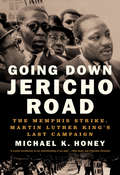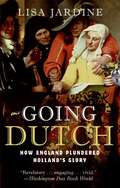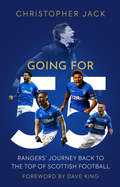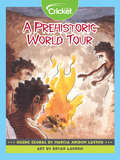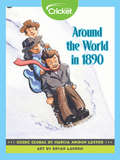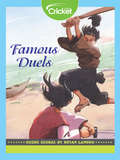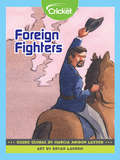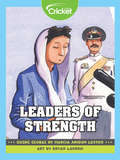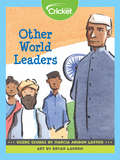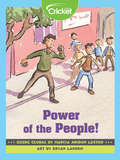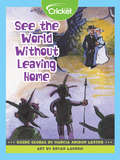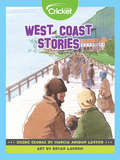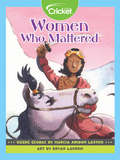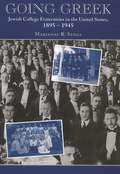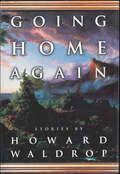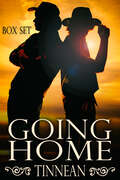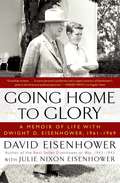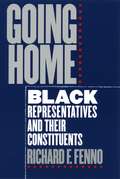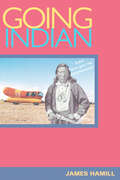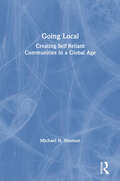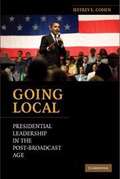- Table View
- List View
Going Down Jericho Road: The Memphis Strike, Martin Luther King's Last Campaign
by Michael K. HoneyThe definitive history of the epic struggle for economic justice that became Martin Luther King Jr.'s last crusade. Memphis in 1968 was ruled by a paternalistic "plantation mentality" embodied in its good-old-boy mayor, Henry Loeb. Wretched conditions, abusive white supervisors, poor education, and low wages locked most black workers into poverty. Then two sanitation workers were chewed up like garbage in the back of a faulty truck, igniting a public employee strike that brought to a boil long-simmering issues of racial injustice. With novelistic drama and rich scholarly detail, Michael Honey brings to life the magnetic characters who clashed on the Memphis battlefield: stalwart black workers; fiery black ministers; volatile, young, black-power advocates; idealistic organizers and tough-talking unionists; the first black members of the Memphis city council; the white upper crust who sought to prevent change or conflagration; and, finally, the magisterial Martin Luther King Jr., undertaking a Poor People's Campaign at the crossroads of his life, vilified as a subversive, hounded by the FBI, and seeing in the working poor of Memphis his hopes for a better America.
Going Dutch: How England Plundered Holland's Glory
by Lisa JardineOn November 5, 1688, William of Orange, Protestant ruler of the Dutch Republic, landed at Torbay in Devon with a force of twenty thousand men. Five months later, William and his wife, Mary, were jointly crowned king and queen after forcing James II to abdicate. Yet why has history recorded this bloodless coup as an internal Glorious Revolution rather than what it truly was: a full-scale invasion and conquest by a foreign nation?The remarkable story of the relationship between two of Europe's most important colonial powers at the dawn of the modern age, Lisa Jardine's Going Dutch demonstrates through compelling new research in political and social history how Dutch tolerance, resourcefulness, and commercial acumen had effectively conquered Britain long before William and his English wife arrived in London.
Going For 55: Rangers' Journey Back to the Top of Scottish Football
by Christopher JackAn insider&’s history of the Rangers Football Club&’s almost-decade-long climb back to the top of Scottish football and their fifty-fifth league title. In February 2012, Rangers faced an uncertain future and fans feared for their club as a Scottish institution was plunged into crisis. Just months later, Rangers would start out on what those supporters christened &“The Journey&” as they attempted to make their way back to the top of the game from the Third Division. The years that followed were amongst the most tumultuous and controversial in the club&’s illustrious history as financial results became as important and noteworthy as football ones. Through it all, Rangers supporters followed near and far. In May 2021, Rangers completed their journey as Steven Gerrard&’s side were crowned Premiership champions.Going for 55 tells the story of the campaign, giving insight and offering analysis into how Gerrard revolutionised the club and restored Rangers to their place at the top of Scottish football. With interviews from the money men who funded the rebuilding job, the staff and players that made the dream a reality and those in the press that saw history being made, this is a sporting tale like no other.
Going Free: American POWs in WWII Philippines (A Vintage Short)
by Hampton SidesAn eBook short.From Hampton Sides's Ghost Soldiers, a gripping narrative of World War II POWs on the brink of freedom. The men of Cabanatuan had been held by the Japanese since the Bataan Death March, in increasingly dire circumstances. With the war turning in the Americans' favor, the POWs worried that their captors would murder them all in the frenzy of an all-out withdrawal. Then one day in early January, 1945, the prison guards simply left. For a brief moment the haggard survivors of Cabanatuan were given the keys to their prison, though swift death was promised to anyone who dared leave. The prisoners waited nervously, all while (unbeknownst to them) a daring raid was being planned which would result in their rescue or their end. This is Hampton Sides at his most riveting, a fitting tribute to these soldiers who would be prisoners no more.
Going Global: A Prehistoric World Tour
by Marcia Amidon LustedA fascinating look at archeological finds in Scotland, South Africa, and Malta that offer clues about ancient civilizations.
Going Global: Around the World in 1890
by Marcia Amidon LustedIn the 1890s, bobsledding became a sport, Van Gogh died, and the Eiffel Tower and Tower of London were built.
Going Global: Borders, Naturally
by Marcia Amidon LustedCheck out these famous countries and regions that owe their shapes to an important geographic feature. These features help dictate so much about the countries they border.
Going Global: Famous Duels
by Marcia Amidon LustedDueling once was used as a way to settle disputes or to defend honor. Some are more well-known than others—explore three of them here!
Going Global: Foreign Fighters
by Marcia Amidon LustedLearn about how foreign soldiers were prized by the Union and Confederate armies because they had experience fighting in European wars.
Going Global: French Colonies
by Marcia Amidon LustedAn overview of how French Colonies have retained French traits. This article covers France's legacy in Cambodia, Canada, Laos, Morocco, and Vietnam.
Going Global: Leaders of Strength
by Marcia Amidon LustedIt takes a strong person to lead a nation. This article explores humble beginnings and massive achievements of several world leaders.
Going Global: Other World Leaders
by Marcia Amidon LustedStrong, democratic leadership can be found around the world. This article describes several world leaders' struggles and achievements.
Going Global: Power of the People!
by Marcia Amidon LustedLearn about Argentina's Week of the People’s Martyrs, Mexico's Night of Tlatelolco, and France's Mai 68.
Going Global: See the World Without Leaving Home
by Marcia Amidon LustedBefore radio, television, and movies, expositions or world fairs such as the World's Columbian Exposition, the 1901 Pan-American Exposition, and the St. Louis World's Fair offered glimpses into faraway cultures and people.
Going Global: West Coast Stories
by Marcia Amidon LustedThe majority of immigrants who passed through Angel Island Immigration Station in the early 20th century came from China and Japan, but large groups also came from a few other nations.
Going Global: Women Who Mattered
by Marcia Amidon LustedThe Revolutionary War created an opportunity for American women to have an impact on the changing world around them. Here's a look at some other women who filled important roles in their respective countries during the same time period.
Going Greek: Jewish College Fraternities in the United States, 1895-1945 (American Jewish Civilization Series)
by Marianne R. SanuaGoing Greek offers an unprecedented look at the relationship between American Jewish students and fraternity life during its heyday in the first half of the twentieth century. More than secret social clubs, fraternities and sororities profoundly shaped the lives of members long after they left college-often dictating choices in marriage as well as business alliances. Widely viewed as a key to success, membership in these self-governing, sectarian organizations was desirable but not easily accessible, especially to non-Protestants and nonwhites. In Going Greek Marianne Sanua examines the founding of Jewish fraternities in light of such topics as antisemitism, the unique challenges faced by Jewish students on campuses across the United States, responses to World War II, and questions pertaining to assimilation and/or identity reinforcement.
Going Home Again: Stories
by Howard WaldropThe words "inimitable" and "unique" are bandied about too often in artistic circles, so much so that critics seem to have forgotten those words were invented to describe Howard Waldrop's fiction.Waldrop's mastery of arcane knowledge, his transcendent wit, and the way his stories explode like cheerty bombs inside a reader's mind have all made Howard Waldrop one of the most beloved writers of the past two decades. Readers who encounter his work never forget the experience, and this new collection compiles nine such experiences (heretofore uncollected), including:"Flatfeet!", a madcap tour of this century's first decades, courtesy of the Keystone Kops."Ocean's Ducks," an homage to those brave black actors of the 1930s. Remember those "Little Moron" jokes in the schoolyard, like "Why did the Little Moron throw the clock out the window?" "He wanted to see Time fly." Now ask yourself again "Why Did?"And beware the masked Mexican wrestlers of "El Castillo de la Perserverancia"!Howard Waldrop's unique and inimitable talents are on full display here. Read on, marvel, and rejoice.
Going Home Box Set
by TinneanThis two-book box set from best-selling M/M author Tinnean contains two historical western novels. Contains the stories:Home Before Sundown: It’s a few years after the Civil War, and George Pettigrew has learned his family is in danger. He’ll do anything to protect them, including wearing a dress. It’s already duped the bad guys, but how will the man he loves react to seeing him in skirts?Two for Home: Zachary “Sharps” Browne and Lieutenant Steve Marriott meet during the Civil War and become friends in spite of battles, troublemakers, and their age difference. After the war, Steve becomes a wagon master, while Sharps works to help heal the recovering nation. When they reunite, will their friendship survive to become more, or will the dangers of the time cause them to be parted forever?
Going Home To Glory: A Memoir of Life with Dwight D. Eisenhower, 1961-1969
by David Eisenhower Julie Nixon EisenhowerWhen President Dwight Eisenhower left Washington, D.C., at the end of his second term, he retired to a farm in historic Gettysburg, Pennsylvania, that he had bought a decade earlier. Living on the farm with the former president and his wife, Mamie, were his son, daughter-in-law, and four grandchildren, the oldest of whom, David, was just entering his teens. In this engaging and fascinating memoir, David Eisenhower--whose previous book about his grandfather, Eisenhower at War, 1943-1945, was a finalist for the Pulitzer Prize--provides a uniquely intimate account of the final years of the former president and general, one of the giants of the twentieth century. In Going Home to Glory, Dwight Eisenhower emerges as both a beloved and forbidding figure. He was eager to advise, instruct, and assist his young grandson, but as a general of the army and president, he held to the highest imaginable standards. At the same time, Eisenhower was trying to define a new political role for himself. Ostensibly the leader of the Republican party, he was prepared to counsel his successor, John F. Kennedy, who sought instead to break with Eisenhower's policies. (In contrast, Kennedy's successor, Lyndon Johnson, would eagerly seek Eisenhower's advice.) As the tumultuous 1960s dawned, with assassinations, riots, and the deeply divisive war in Vietnam, plus a Republican nominee for president in 1964 whom Eisenhower considered unqualified, the former president tried to chart the correct course for himself, his party, and the country. Meanwhile, the past continued to pull on him as he wrote his memoirs, and publishers and broadcasters asked him to reminisce about his wartime experiences. When his grandfather took him on a post-presidential tour of Europe, David saw firsthand the esteem with which monarchs, prime ministers, and the people of Europe held the wartime hero. Then as later, David was under the watchful eye of a grandfather who had little understanding of or patience with the emerging rock 'n' roll generation. But even as David went off to boarding school and college, grandfather and grandson remained close, visiting and corresponding frequently. David and Julie Nixon's romance brought the two families together, and Eisenhower strongly endorsed his former vice-president's successful run for the presidency in 1968. With a grandson's love and devotion but with a historian's candor and insight, David Eisenhower has written a remarkable book about the final years of a great American whose stature continues to grow.
Going Home to Glory: A Memoir of Life with Dwight D. Eisenhower, 1961-1969
by David Eisenhower Julie Nixon EisenhowerWhen President Dwight Eisenhower left Washington, D.C., at the end of his second term, he retired to a farm in historic Gettysburg, Pennsylvania, that he had bought a decade earlier. Living on the farm with the former president and his wife, Mamie, were his son, daughter-in-law, and four grandchildren, the oldest of whom, David, was just entering his teens. In this engaging and fascinating memoir, David Eisenhower--whose previous book about his grandfather, Eisenhower at War, 1943-1945, was a finalist for the Pulitzer Prize--provides a uniquely intimate account of the final years of the former president and general, one of the giants of the twentieth century. In Going Home to Glory, Dwight Eisenhower emerges as both a beloved and forbidding figure. He was eager to advise, instruct, and assist his young grandson, but as a general of the army and president, he held to the highest imaginable standards. At the same time, Eisenhower was trying to define a new political role for himself. Ostensibly the leader of the Republican party, he was prepared to counsel his successor, John F. Kennedy, who sought instead to break with Eisenhower's policies. (In contrast, Kennedy's successor, Lyndon Johnson, would eagerly seek Eisenhower's advice.) As the tumultuous 1960s dawned, with assassinations, riots, and the deeply divisive war in Vietnam, plus a Republican nominee for president in 1964 whom Eisenhower considered unqualified, the former president tried to chart the correct course for himself, his party, and the country. Meanwhile, the past continued to pull on him as he wrote his memoirs, and publishers and broadcasters asked him to reminisce about his wartime experiences. When his grandfather took him on a post-presidential tour of Europe, David saw firsthand the esteem with which monarchs, prime ministers, and the people of Europe held the wartime hero. Then as later, David was under the watchful eye of a grandfather who had little understanding of or patience with the emerging rock 'n' roll generation. But even as David went off to boarding school and college, grandfather and grandson remained close, visiting and corresponding frequently. David and Julie Nixon's romance brought the two families together, and Eisenhower strongly endorsed his former vice-president's successful run for the presidency in 1968. With a grandson's love and devotion but with a historian's candor and insight, David Eisenhower has written a remarkable book about the final years of a great American whose stature continues to grow.
Going Home: Black Representatives And Their Constituents
by Richard F. FennoThirty years ago there were nine African Americans in the U. S. House of Representatives. Today there are four times that number. In Going Home, the dean of congressional studies, Richard F. Fenno, explores what representation has meant--and means today--to black voters and to the politicians they have elected to office. Fenno follows the careers of four black representatives--Louis Stokes, Barbara Jordan, Chaka Fattah, and Stephanie Tubbs Jones--from their home districts to the halls of the Capitol. He finds that while these politicians had different visions of how they should represent their districts (in part based on their individual preferences, and in part based on the history of black politics in America), they shared crucial organizational and symbolic connections to their constituents. These connections, which draw on a sense of "linked fates," are ones that only black representatives can provide to black constituents. His detailed portraits and incisive analyses will be important for anyone interested in the workings of Congress or in black politics.
Going Indian
by James HamillGoing Indian explores Indian (as opposed to tribal) ethnic identity among Native American people in Oklahoma through their telling, in their own words, of how they became Indian and what being Indian means to them today. Divided into four parts, the book features Oklahoma Indians' constructions of their histories and their view of today's native populations, their experiences with forced removals and Indian educational institutions, the meaning they place on blood quantum and ancestry in relation to Indian identity, and their practice of religion in Native churches. James Hamill makes extensive use of the Indian Pioneer and Doris Duke material at the University of Oklahoma's Western History Library to assemble these narratives, using interviews collected between 1937-38 and 1967-70, as well as interviews he conducted from 2000 to 2001. While most books on Native American people in Oklahoma focus on tribes and their histories, Hamill instead explores the use of Indian symbolism across a wide field of experience to reveal what they thought and what they think about these various issues, and how these have influenced and affected their self-perceptions over time.
Going Local: Creating Self-Reliant Communities in a Global Age
by Michael ShumanNational drug chains squeeze local pharmacies out of business, while corporate downsizing ships jobs overseas. All across America, communities large and small are losing control of their economies to outside interests. Going Local shows how some cities and towns are fighting back. Refusing to be overcome by Wal-Marts and layoffs, they are taking over abandoned factories, switching to local produce and manufactured goods, and pushing banks to loan money to local citizens. Shuman details how dozens of communities are recapturing their own economies with these new strategies, investing not in outsiders but in locally owned businesses.
Going Local: Presidential Leadership in the Post-Broadcast Age
by Jeffrey E. CohenGoing public to gain support, especially through reliance on national addresses and the national news media, has been a central tactic for modern presidential public leadership. In Going Local: Presidential Leadership in the Post-Broadcast Age, Jeffrey E. Cohen argues that presidents have adapted their going-public activities to reflect the current realities of polarized parties and fragmented media. Going public now entails presidential targeting of their party base, interest groups, and localities. Cohen focuses on localities and offers a theory of presidential news management that is tested using several new data sets, including the first large-scale content analysis of local newspaper coverage of the president. The analysis finds that presidents can affect their local news coverage, which, in turn, affects public opinion toward the president. Although the post-broadcast age presents hurdles to presidential leadership, Going Local demonstrates the effectiveness of targeted presidential appeals and provides us with a refined understanding of the nature of presidential leadership.
